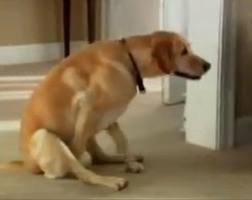 Anal glands are two small scent glands, located under the skin on either side of the rectum. They are present in both dogs and cats. They are designed to empty their secretion onto the animal’s bowel motions, being stimulated to contract by the stretching of the anal sphincter muscle when faeces are passed. If your dog has never had a problem with them, you are unlikely to know they even exist.
In the canine world, dogs mark out their territorial boundaries using their urine (which is also scented), and faeces. The unique scent produced by each dog’s anal glands sends out a clear message as to “who’s turf you are on”. This is also the reason why when unfamiliar dogs meet, they always indulge in session of tail lifting and bottom sniffing….the canine equivalent of a hand shake and formal introduction.
Anal gland blockage, or infection, is a common problem in domestic dogs, and occasionally in cats. The classic signs of anal gland problems in dogs, is “scooting” when a dog drags its bottom along the ground. This is commonly mistaken as a sign of worms (tapeworm infestation can occasionally cause scooting), but is far more likely to be anal gland irritation.
Expressing, or unblocking, the gland(s) is an unpleasant job, for both dog, owner, and veterinarian. It is achieved by physically squeezing the glands, either externally, or per rectum, and manually removing the secretion build up. It can be quite painful for the dog, if the glands are very blocked, or infected. And the smell…aaaagh !! ....it doesn’t get much worse, and I’ve smelt some pretty bad things, as a vet!
Once the glands have been expressed, the signs of irritation will usually disappear quickly, unless they are all ready infected. But it is unfortunately common that they can be blocked and full again within months. With chronic blockage, the sacs can form abscesses, and sometimes will require surgical removal.
Anal glands are two small scent glands, located under the skin on either side of the rectum. They are present in both dogs and cats. They are designed to empty their secretion onto the animal’s bowel motions, being stimulated to contract by the stretching of the anal sphincter muscle when faeces are passed. If your dog has never had a problem with them, you are unlikely to know they even exist.
In the canine world, dogs mark out their territorial boundaries using their urine (which is also scented), and faeces. The unique scent produced by each dog’s anal glands sends out a clear message as to “who’s turf you are on”. This is also the reason why when unfamiliar dogs meet, they always indulge in session of tail lifting and bottom sniffing….the canine equivalent of a hand shake and formal introduction.
Anal gland blockage, or infection, is a common problem in domestic dogs, and occasionally in cats. The classic signs of anal gland problems in dogs, is “scooting” when a dog drags its bottom along the ground. This is commonly mistaken as a sign of worms (tapeworm infestation can occasionally cause scooting), but is far more likely to be anal gland irritation.
Expressing, or unblocking, the gland(s) is an unpleasant job, for both dog, owner, and veterinarian. It is achieved by physically squeezing the glands, either externally, or per rectum, and manually removing the secretion build up. It can be quite painful for the dog, if the glands are very blocked, or infected. And the smell…aaaagh !! ....it doesn’t get much worse, and I’ve smelt some pretty bad things, as a vet!
Once the glands have been expressed, the signs of irritation will usually disappear quickly, unless they are all ready infected. But it is unfortunately common that they can be blocked and full again within months. With chronic blockage, the sacs can form abscesses, and sometimes will require surgical removal.


